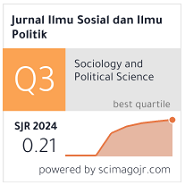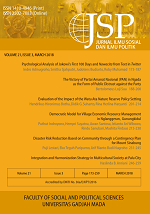Transformational Bureaucratic Leadership Model to Support National Defense Policy in Indonesia
Sjafrie Sjamsoeddin(1*), Purnomo Yusgiantoro(2), Herlina Juni Risma Saragih(3), Budi Susilo Soepandji(4)
(1) Doctoral Program of Defense Science, Republic of Indonesia Defense University, Indonesia
(2) Doctoral Program of Defense Science, Republic of Indonesia Defense University, Indonesia
(3) National Security Faculty, Republic of Indonesia Defense University, Indonesia
(4) Faculty of Engineering, University of Indonesia, Indonesia
(*) Corresponding Author
Abstract
Globalization has produced a complex strategic environment, posting a dynamic threat to national security. In this case, a strategic form of leadership becomes important in running a country, especially in the context of national defense. The purpose of this article is to reveal the bureaucratic leadership style that can function as a form of strategic leadership in national defense policy. Based on the literature study method, it was found that a transformational bureaucratic leadership model can be a form of strategic leadership in National Defense Policy in Indonesia. Leadership transformation is carried out through competency development in the form of superior leadership abilities and attitudes that are in accordance with the needs of the times. With this competence, bureaucratic leaders are expected to perform their leadership duties proportionately and handle any problems that may arise in their organization. The guardian leadership that can motivate, encourage, and serve as an example for their subordinates will be crucial in the realization of the bureaucratic leadership style to support national defense policy. Characteristics of a leader with honor, creativity, discipline, motivation, anticipation, guardianship, spirit of nationalism and patriotism, and integrity will have a positive impact on the National Defense Policy. By combining breakthroughs with a type of continuous control, the division of specific tasks at specific organizational level, and Millennial HR’s involvement, a leadership approach will be able to explore the potential to produce organizational performance far above what has been achieved so far, in particular in Indonesian National Defense policy management.
Keywords
Full Text:
PDFReferences
Abdullah, E. (2021). Kepemimpinan Birokrasi yang Andal. Kompas.
Adawiyah, & Tuti. (2020). Kepemiminan Walikota Surabaya Tri Rismaharini sebagai Model Birokrasi Efektif. Perspektif Komunikasi: Jurnal Ilmu Komunikasi Politik Dan Komunikasi Bisnis, 4(1), 73–82. https://doi.org/10.24853/pk.4.1.73-82
Anwaruddin, A. (2006). Improving Public Service D el i very thro ugh B urea uc ra c y Refo rm ADB- NPASIPAG Conference Papers. ADB- INTAN.
Bordens, & Abbott. (2011). Research Design and Methods. A process Approach Eighth Edition. Mc Graw Hill.
David, F. R. (2017). Strategic Management: A Competitive Advantage Approach, Concept and Cases 16th Edition. Pearson Education Limited.
Fukushima. (2001). Understanding Leadership in Japan. Japantimes.
Kurniasih. (2020). Problematika Birokrasi dalam Pemerintahan. Jurnal Lingkaran Widyaswara, 7(1), 17–22.
Lay, M. R. (2021). Model Kepemimpinan Birokrasi Pemberdaya. Jurnal Administrasi Publik, 16(2), 2021.
Ma, M. (2018). Transpersonal Leadership Series: White Paper Six. Leadership in China: Harnessing Chinese Wisdom for Global Leadership?. Rouletdge Taylor & Francis Group.
Mattayang, B. (2019). Tipe dan Gay a Kepemimpinan : Suatu Tinjauan Teoritis. Journal of Economic, Management and Accounting , 2(2) . http://dx.doi. org/10.35914/jemma.v2i2.247
McFarlin, K. (2021). What is a Strategic Leader?. Smallbusiness.
Ministry of Defense of the Republic of Indonesia. (2015). Indonesian Defence White Paper. Ministry of Defense.
Noer, E. (2019). Kepemimpinan Strategis dan Perubahan pada Perguruan Tinggi. Jurnal Ilmu Ekonomi & Sosial, 10(2), 59–70. 10.35724/jies.v10i2. 2409.
Noval, M. (2019). Banyak isu-isu Nasional Pertahanan dan Keamanan Negara yang Perlu dikaji. Litbang Kemendagri.
Nurhadi, H. (2021). Kepemimpinan Strategis dan Manajemen Perubahan.
Osborne, D., & Plastrik, P. (2000). Memangkas Birokrasi. 5 Strategi menuju pemerintahan wirausaha. CV Teruna Grafica.
Ramadhan, & Dwipayana. (2008). Soeharto: Pikiran, ucapan dan tindakan saya: autobiograpi.
Rimbe, M. (2019). Inilah 5 Fakta Hari Pendidikan Nasional dan Sosok Ki Hadjar Dewantara.
Rothaerment, F. T. (2015). Strategic Management. McGraw-Hill.
Rudianto, C. (2020). Kepemimpinan Strategis ala Susilo Bambang Yudhoyona.
Sekaran, U., & Bougie, R. (2017). Metode Penelitian untuk Bisnis: Pendekatan Pengembangan- Keahlian, Edisi 6, Buku 1, Cetakan Kedua. Salemba Empat.
Siagian, S. P. (2013). Teori & Praktik Kepemimpinan. Rineka Cipta.
Sinek, S. (2014). Leaders eat last: why some teams pull together and others don’t. Penguin Group.
Sjamsoeddin, S. (2012). Penghormatan dan Kehormatan TNI. Kompas Nasional.
Sjamsoeddin, S. (2016). Komitmen dan Perubahan. Suatu Persepsi dan Perspektif. Ministry of Defense of the Republic of Indonesia.
Sjamsoeddin, S. (2017). Kepemimpinan dan Komunikasi Strategis. Bahan kuliah umum Sesko TNI.
Sjamsoeddin, S. (2019). Kepemimpinan dalam Situasi Krisis. Bahan kuliah Umum Universitas Kebangsaan RI.
Sugiman. (2017). Penanaman Nilai-Nilai Nasionalisme dan Patriotisme melalui Materi Sikap Semangat Kebangsaaan dan Patriotism e dalam Kehidupan Bermasyarakat, Berbangsa dan Bernegara pada Pembelajaran PKn di SMA N 1 Pundong. Academy of Education Journal. Pendidikan Pancasila Dan Kewarganegaraan, 8(2).
Sugiyanto, E. (2016). Pengendalian dalam Organisasi. LPU-UNAS.
Supriyatno, M. (2018). Kepemimpinan Strategis Sektor Pertahanan dan Keamanan di Indonesia. Binus Business Review, 2018.
Suspurwanto, J. (2020). Kepemimpinan St rategis Jenderal Sudirman dalam Pengabdiannya sebagai Prajurit Tentara Nasional Indonesia. Jurnal Strategi Pertahanan Semesta, 6(1). https://doi. org/10.56555/sps.v6i1.537
Tambun, L. (2022). Gelar Rapim, Prabowo Ungkap 7 Kebijakan Pertahanan. Berita Satu.
Article Metrics
Refbacks
- There are currently no refbacks.
Copyright (c) 2023 Jurnal Ilmu Sosial dan Ilmu Politik

This work is licensed under a Creative Commons Attribution-NonCommercial-NoDerivatives 4.0 International License.






















